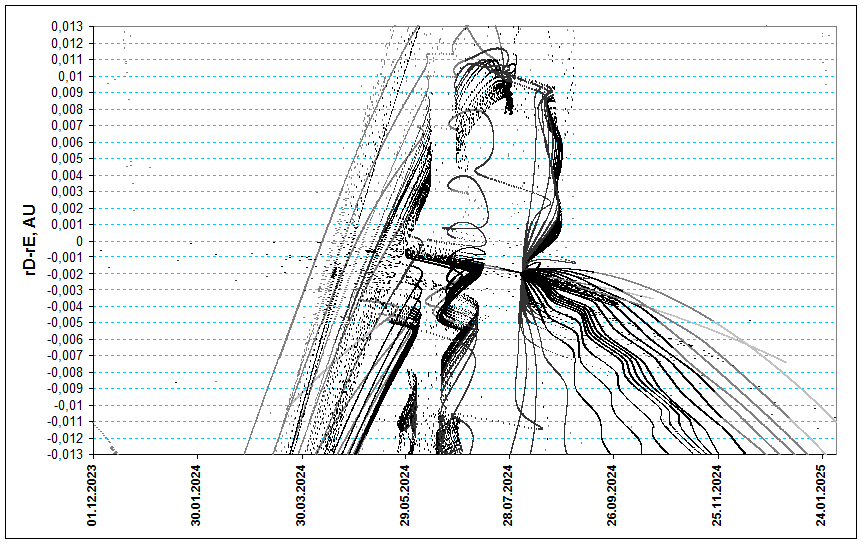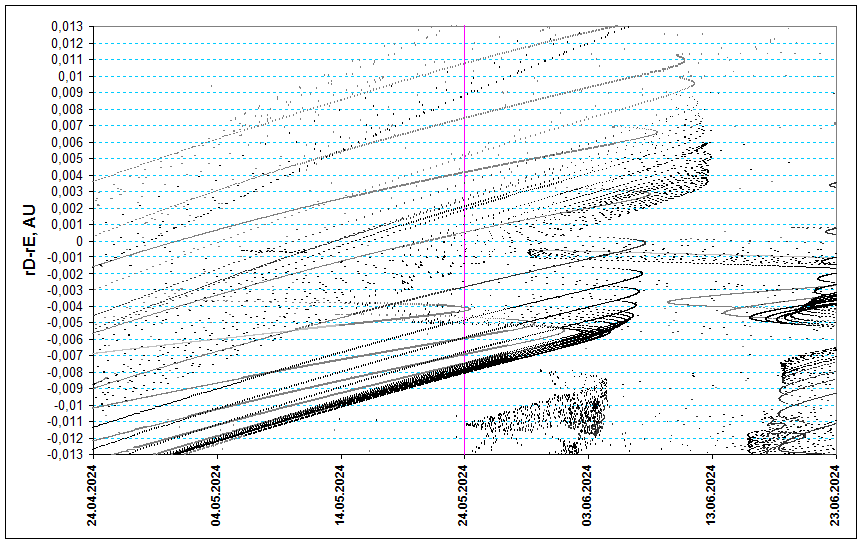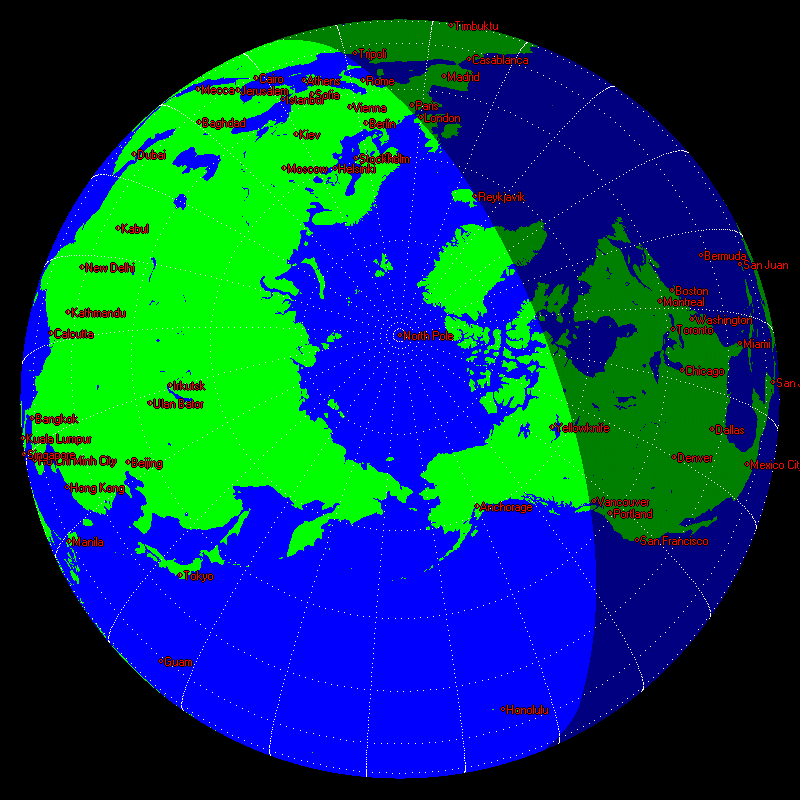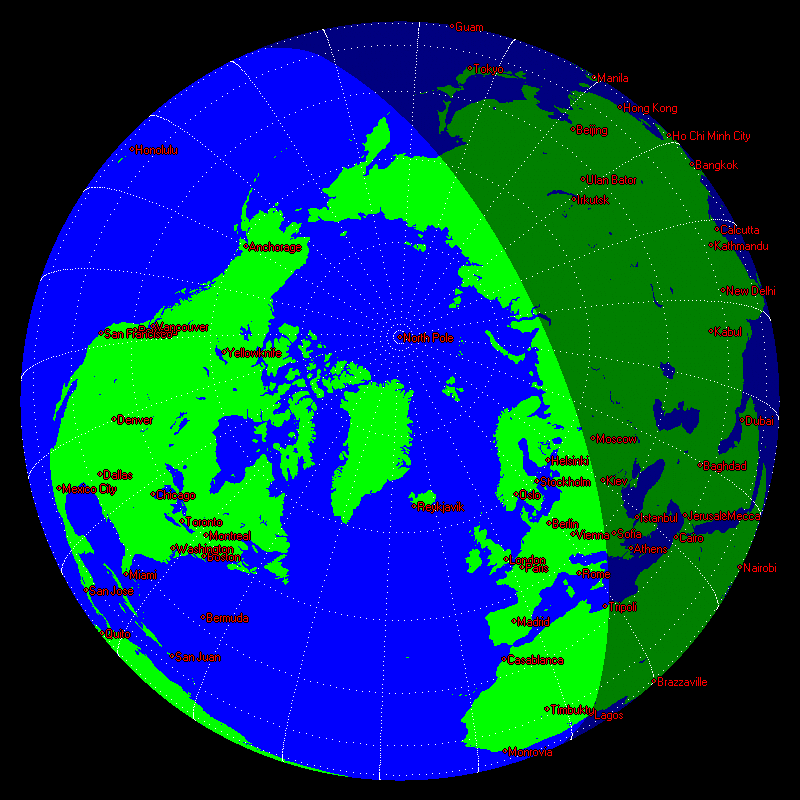209P-ids 2024: prediction of activity
to the list of predictions

Fig. 1. Space-temporal projection of 209P-ids trails parts onto their minimal distance passages in 2024 (correspondence between colours of the particles and their ejection velocities can be seen here).
In 2024 the next perihelion of the comet 209P/LINEAR occurs. Two previous perihelia in 2014 and 2019 brought weak activity of a new meteor shower with the radiant in Camelopardalis. In 2024 some meteor activity appearance is also likely though parameters of the Earth encounters with trails of the comet 209P are worse than in 2014 and 2019.

Fig. 2. Detailed space-temporal projection of 209P-ids trails parts onto their minimal distance passages in 2024.
Computation results suggest the following possible cases of the comet 209P meteor shower activity in 2024:
1. May 23 at 4 UT, perhaps it would be quite lengthy activity for several hours around this moment of time. The cause of the Earth encounter with old cometary material ejected by the comet in 19 and 18 centures and probably even earlier. These trails are not dense but altogether they could produce some detectable activity. The encountering particles have small negative ejection velocities, mainly in the range from -3 to -5 m/s which is a negative factor for expected activity but in our opinion chances for some detectable meteor activity are still quite high.
2. May 23 at 10:46 UT. An encounter with the younger 1929 trail which is a denser and more regular one comparing to those from 18 and 19 centures. Computed distance to the trail is only 0.00039 AU but ejection velocity on particles in the encountered part of the trail is -12.6 m/s which is quite high negative value significanlty decreasing chances for any detectable activity. Still it is desirable for this case to check what happens.
3. May 23 at 17:56 UT. An encounter with the 1934 trail. It is analogous in many aspects to the encounter with 1929 trail but for the 1934 trail the distance is much greater, it is 0.0029o AU, while ejection velocoty of encountered trail particle is somewhat more favorable, it equals to -9.3 m/s. Nevertheless due to significant distance to the trail chances for any detectable activity are very low though this case should also be checked with observations.
1. May 23 at 4 UT, perhaps it would be quite lengthy activity for several hours around this moment of time. The cause of the Earth encounter with old cometary material ejected by the comet in 19 and 18 centures and probably even earlier. These trails are not dense but altogether they could produce some detectable activity. The encountering particles have small negative ejection velocities, mainly in the range from -3 to -5 m/s which is a negative factor for expected activity but in our opinion chances for some detectable meteor activity are still quite high.
2. May 23 at 10:46 UT. An encounter with the younger 1929 trail which is a denser and more regular one comparing to those from 18 and 19 centures. Computed distance to the trail is only 0.00039 AU but ejection velocity on particles in the encountered part of the trail is -12.6 m/s which is quite high negative value significanlty decreasing chances for any detectable activity. Still it is desirable for this case to check what happens.
3. May 23 at 17:56 UT. An encounter with the 1934 trail. It is analogous in many aspects to the encounter with 1929 trail but for the 1934 trail the distance is much greater, it is 0.0029o AU, while ejection velocoty of encountered trail particle is somewhat more favorable, it equals to -9.3 m/s. Nevertheless due to significant distance to the trail chances for any detectable activity are very low though this case should also be checked with observations.

Fig. 3. The Earth as seen from coming 209P-ids meteors (RA=124.8°, Dec=+80.3°) during the expected maximum time of outburst from 18 and 19 centuries trails at 4 UT UT on 23 May.

Fig. 4. The Earth as seen from coming 209P-ids meteors (RA=123.3°, Dec=+80.3°) during the expected maximum time of outburst from 1929 trail at 10:46 UT on 23 May.

Fig. 5. The Earth as seen from coming 209P-ids meteors (RA=123.3°, Dec=+80.3°) during the expected maximum time of outburst from 1934 trail at 17:56 UT on 23 May.
It can be seen that time of the first maximum is favorable for night time observations in the major part of the Northern America as well as, to the less extent, on the extreme west of the Europe and north-eastern coast of Africa.
The time of the second maximum is favorable for the south eastern part of Northern America as well for extremely eastern parts of Eurasia and, a bit more favorable, for Japan.
The third maximum could be observed in the night time on major part of Eurasia excluding northern and western parts, as well as in north-easters coast of Africa.
Unfortunately the Moon will be full on the day of expected maxima, so observing conditions will be significantly worsened by the moonlight. Still observations are recommended at the expected encounter times.
Ссылки
1. "Comet's dust 2.0" program by S. Shanov and S. Dubrovsky. [Used for orbital computations.]
2. E. Lyytinen, T. van Flandern "Predicting the strength of Leonid outbursts", 2000, Earth, Moon, and Planets, P. 149-166.
3. Jenniskens P. Meteor showers and their parent comets, 2006, 780 p. 4. Kasuo Kinoshita, http://jcometobs.web.fc2.com/ [Orbital elements of the comet 209P/LINEAR]
5. Hewgill G. Xearth 1.1.0 (Software program), 2003. 6. Molau S. Results of the IMO Video Meteor Network – December 2014. http://www.imonet.org/reports/201412.pdf 7. 2016 Meteor Shower Calendar, http://imo.net/files/data/calendar/cal2016.pdf
The time of the second maximum is favorable for the south eastern part of Northern America as well for extremely eastern parts of Eurasia and, a bit more favorable, for Japan.
The third maximum could be observed in the night time on major part of Eurasia excluding northern and western parts, as well as in north-easters coast of Africa.
Unfortunately the Moon will be full on the day of expected maxima, so observing conditions will be significantly worsened by the moonlight. Still observations are recommended at the expected encounter times.
Ссылки
1. "Comet's dust 2.0" program by S. Shanov and S. Dubrovsky. [Used for orbital computations.]
2. E. Lyytinen, T. van Flandern "Predicting the strength of Leonid outbursts", 2000, Earth, Moon, and Planets, P. 149-166.
3. Jenniskens P. Meteor showers and their parent comets, 2006, 780 p. 4. Kasuo Kinoshita, http://jcometobs.web.fc2.com/ [Orbital elements of the comet 209P/LINEAR]
5. Hewgill G. Xearth 1.1.0 (Software program), 2003. 6. Molau S. Results of the IMO Video Meteor Network – December 2014. http://www.imonet.org/reports/201412.pdf 7. 2016 Meteor Shower Calendar, http://imo.net/files/data/calendar/cal2016.pdf